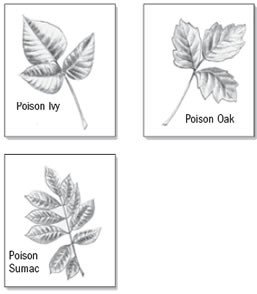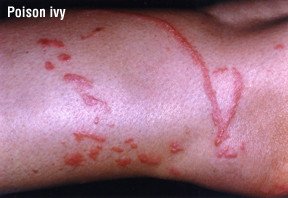Contact Dermatitis
Medically reviewed by Drugs.com. Last updated on Mar 1, 2024.
What is Contact Dermatitis?

Contact dermatitis is skin inflammation. It occurs because the skin has been exposed to a substance that irritates it or causes an allergic reaction.
Many natural and artificial chemicals can trigger contact dermatitis. These include ingredients found in:
- Antibiotic ointments
- Cosmetics
- Fabric finishes
- Household cleaners
- Industrial solvents
- Laundry detergents
- Metal jewelry
- Perfumes
- Shampoos
- Soaps
Common skin exposure (contact) that can lead to contact dermatitis includes:
- Applying makeup or hair dye
- Hand washing
- Hiking near poison ivy, oak or sumac
- Housecleaning
- Shampooing hair
- Sitting near a campfire where poison ivy is being burned.
- Spraying or dabbing on perfume
- Wearing a diaper
- Wearing a metal necklace or bracelet that contains nickel
- Wearing clothes with metal snaps or zippers
- Working with industrial solvents
|
|
Doctors classify contact dermatitis into two types. The type depends on the cause of inflammation:
- Irritant contact dermatitis. This is triggered by exposure to a chemical that is poisonous (toxic) or irritating to the skin. It is not an allergic reaction.
In children, the most common form of irritant contact dermatitis is "diaper rash." This is a skin reaction in the diaper area. It is caused by prolonged contact with the natural chemicals found in urine and stool. Childhood irritant contact dermatitis also can develop around the mouth because of skin contact with dribbles of baby food or drools of saliva.
In adults, this condition is often an occupational illness. It is triggered by exposure to strong soaps, solvents or cutting agents. It is especially common among:
- Hairdressers
- Health care workers
- Homemakers
- Janitors
- Machinists
- Mechanics
But it can occur in anyone whose household chores or hobbies involve exposure to irritating chemicals.
- Allergic contact dermatitis. This is an immune reaction. It occurs only in people who are naturally oversensitive to certain chemicals.
With allergic contact dermatitis, the inflammation may not develop until 24 to 36 hours after contact with the allergen. This is because allergic contact dermatitis involves the body's immune defenses. The immune response is a process that takes some time.
Skin allergies vary from person to person. The most common types of allergens responsible are:
- A chemical found in poison ivy, oak and sumac
- Nickel and cobalt in metal jewelry, clothing snaps, zippers and metal-plated objects
- Latex in gloves and rubberized clothing
- Neomycin in antibiotic skin ointments
- Potassium dichromate, a tanning agent found in leather shoes and clothing
- Certain preservatives, such as formaldehyde

Symptoms
Symptoms of contact dermatitis may vary slightly, depending on the cause.
Irritant contact dermatitis. In mild cases, there may be only mild redness of the skin. More severe cases may cause skin swelling, blistering or ulceration.
Symptoms usually begin right after exposure to the harmful substance. They are limited to areas of the skin that have been in direct contact with the irritant. For example, a janitor may develop symptoms on his hands after washing the floor with a strong detergent.
Allergic contact dermatitis. This usually causes skin redness, blistering and severe itching. Symptoms may not appear for several hours or even days after exposure.
The location and pattern of the skin reaction may provide clues to the cause of the problem. For example, poison ivy usually appears as a pattern of tiny lines or streaks in places where plant leaves have brushed against the skin. Allergies to metal jewelry often cause rings of skin inflammation around the neck and wrist.
Contact dermatitis can become a long-lasting (chronic) condition. This is more likely if:
- Symptoms of either type of dermatitis are not treated
- The skin continues to be exposed to the substance that is triggering the skin reaction
In chronic contact dermatitis, the skin eventually becomes thick, scaly and dry. Skin color changes and there are areas of hair loss.
Diagnosis
Depending on your pattern of skin symptoms, the doctor will ask about your:
- Contact with poisonous plants
- History of exposure to irritating chemicals at work or at home
- Personal and family allergy history
In some cases, your doctor may need to ask for the names of specific ingredients in your personal care products. In particular, the doctor will ask about:
- Antibiotic skin ointments.
- Cosmetics
- Hair dyes
- Nail polish
- Shampoos
- Skin lotions
After reviewing your history of allergies and chemical exposures, your doctor usually can confirm the diagnosis of contact dermatitis by examining your skin.
If your doctor suspects allergic contact dermatitis and cannot identify the likely allergen, your doctor may refer you to a dermatologist for patch testing. Small amounts of specific allergens are applied to the skin of your back, and then covered with tape. After 48 hours, the doctor removes the tape. He or she examines the skin for signs of an allergic reaction. A second reading is done after three to seven days.
Expected Duration
With proper treatment, your symptoms probably will clear up within two to three weeks. However, you must stop exposing your skin to the irritating substance.
If you continue to have long-term exposure to harmful chemicals or allergens, you eventually may develop symptoms of chronic contact dermatitis. This can last for many years.
Prevention
In general, you can prevent contact dermatitis by avoiding exposure to irritating chemicals, plants, jewelry and
n general, you can prevent contact dermatitis by avoiding exposure to irritating chemicals, plants, jewelry and other substances that trigger irritant or allergic contact dermatitis.
To help prevent diaper dermatitis:
- Change baby diapers frequently
- Clean the soiled area with warm water and a soft cloth
- Avoid using store-bought wipes and cleansers on your child's skin. These products can trigger skin reactions.
- Apply a protective coat of zinc oxide ointment
Treatment
Your doctor usually will treat contact dermatitis with the following:
- An oral antihistamine to control the itch. Common antihistamines include:
- Diphenhydramine (Benadryl)
- Hydroxyzine (Atarax)
- Cetirizine (Zyrtec)
- Loratadine (Claritin)
- Fexofenadine (Allegra)
Of these, the last three are less likely to cause drowsiness.
- A corticosteroid to relieve skin inflammation. In most cases, the corticosteroid can be applied as a cream or ointment. If symptoms are severe, corticosteroids can be given by mouth or by injection.
- A moisturizer to help restore the normal texture of the skin. Your doctor may suggest a nonirritating ointment or cream that contains few potential allergens. Examples include:
- Petroleum jelly
- Vanicream
- Cetaphil
- Eucerin
For many people, oatmeal baths (Aveeno) also help.
Treatment options
The following list of medications are related to or used in the treatment of this condition.
When To Call a Professional
Call your doctor whenever you are troubled by red and very itchy skin. Also call if your skin is cracked, blistered or painfully dry.
Even if you are certain that your skin problem is "just a case of poison ivy," call your doctor's office for advice. He or she may be able to prescribe a more effective medication than over-the-counter remedies.
Prognosis
For most cases of contact dermatitis, the outlook is excellent. This is provided you can identify the substance that triggered your contact dermatitis and avoid it in the future.
Additional Info
National Institute of Arthritis and Musculoskeletal and Skin Diseases
https://www.niams.nih.gov/
American Academy of Dermatology
https://www.aad.org/
Learn more about Contact Dermatitis
Treatment options
Care guides
Medicine.com guides (external)
Further information
Always consult your healthcare provider to ensure the information displayed on this page applies to your personal circumstances.

